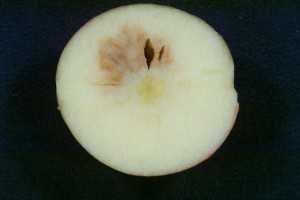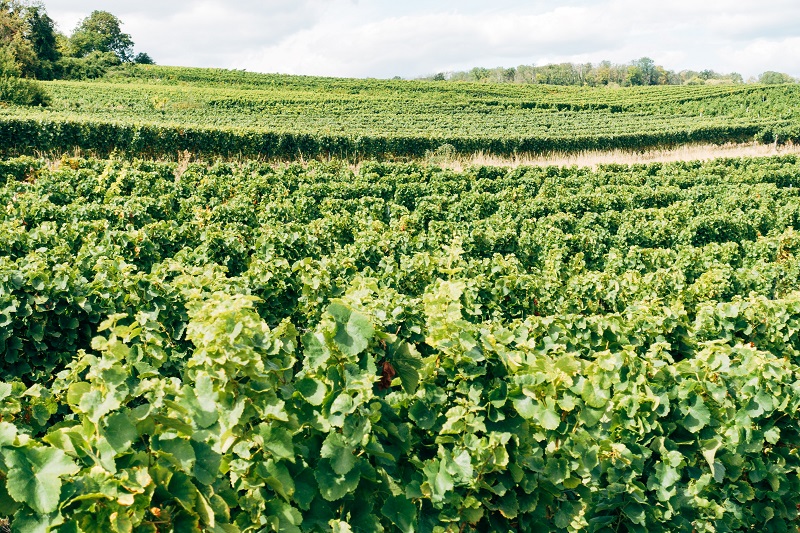How To Successfully Store Honeycrisp

This photo demonstrates a chilling injury on Honeycrisp that is due to excessive carbon dioxide in controlled atmosphere storage. (Photo Credit: Randy Beaudry)
With more Honeycrisp apple trees being put in the ground and harvested each year, this means more apples are being put in storage. Given the variety’s sensitivity to low temperatures, researchers around the country are studying some postharvest treatments on Honeycrisp apples to prevent injury due to cold temperatures.
“Honeycrisp is a really difficult apple to grow and store,” says Randy Beaudry, Michigan State University (MSU) AgBioResearch horticulturist. “What we want to do is look at low oxygen environments, slightly elevated carbon dioxide environments, and try to store the fruit for a longer period of time than we can with simple refrigeration.”
Desensitize The Apples
Beaudry and his research team developed a treatment to desensitize the fruit to low temperature storage. He advises growers to precondition the fruit at 50°F and store at 38°F. But, in doing so, Beaudry acknowledges that the potential storability is compromised because storing the variety at a higher temperature will leave the variety with a shorter storage period.
What Beaudry and his research team also found was that the variety is very susceptible to carbon dioxide injury as well as low temperatures.
“At oxygen levels of 3% or below, we get internal browning, which is basically cell death on the inside of the fruit, and that is exacerbated by carbon dioxide,” he explains. “We’ve been looking at protocols for preventing that controlled atmosphere injury.”
Three Strategies For Storing Honeycrisp
Beaudry says there are three strategies for storing Honeycrisp, given its sensitivity to low oxygen and
carbon dioxide.
The first option is to use an extended preconditioning period and delay harvest storage for five days at elevated temperatures, at 68°F.
“That’s a very high temperature and it worries a lot of folks to do that,” says Beaudry. “It’s not a lot different from what they were already doing for low temperature, but in this case, we just elevated the temperature a little bit during that conditioning period. Now they successfully resist disorders in storage.”
The second option is to avoid CA storage and to use SmartFresh, a gas that is released to stop ethylene action.
“If we can use air storage in combination with SmartFresh then we’re able to slow down the ripening without necessarily using controlled atmospheres for storability,” he explains.
The third option, says Beaudry, is to use diphenylamine, or DPA. DPA is “a commonly used material that prevents another disorder called superficial scald or storage scald, but also prevents CA injury.”
Maximize Storage Potential
Beaudry advises that growers can use all three options in combination in order to maximize the storage potential for Honeycrisp. He also recommends that if growers choose to store the apples in a CA building, to make sure that the apples are not exposed to carbon dioxide at all during the first month, especially as fruit is being loaded into the building. Beaudry suggests growers either use a carbon scrubber or hydrated lime to remove the CO2.
No CO2
Beaudry says it is of paramount concern to growers to remove the carbon dioxide while loading fruit into storage.
“We had several million dollars’ worth of Honeycrisp lost out of Washington state two years ago, and the reason was that during the loading period, they didn’t vent the room. They just put the fruit in the room and kept loading the room until it was full,” says Beaudry. “Then they started adjusting the atmosphere. What they forgot was that those fruit are alive and carbon dioxide built up to around 5% in the room in that four- to seven-day loading period. That was enough to cause the fruit load to be lost.”
Beaudry sees the importance of this research, saying the Honeycrisp harvest is “worth tens of millions of dollars to the industry out there. We’ve got to do it right. There’s no other choice.”
Honeycrisp Help
Here are some resources from several universities to improve your production of Honeycrisp:
- University of Minnesota
- Michigan State University
- Washington State University Extension
- Cornell University Extension










